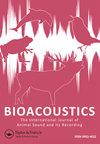Characterisation and classification method of burst pulses produced by Guiana dolphins (Sotalia guianensis)
IF 2.1
4区 生物学
Q2 ZOOLOGY
Bioacoustics-The International Journal of Animal Sound and Its Recording
Pub Date : 2021-02-17
DOI:10.1080/09524622.2021.1886169
引用次数: 1
Abstract
ABSTRACT Although burst pulses are the least studied sounds produced by odontocetes, their characterisation is essential to describe the acoustic repertoire of a species. This study aimed to characterise burst pulses produced by Guiana dolphins and propose a visual method to classify these sounds into structural categories. Data collection occurred during boat surveys in south-eastern Brazil. Five acoustic parameters were extracted: number of pulses, duration, interclick interval, click repetition rate, and minimum frequency. All sounds were visually classified into four categories and used in a discriminant function analysis. In addition, a K-means cluster was used to compare the visual classification with this unsupervised grouping method and confirm the representativeness of each category. According to the discriminant analysis, most sounds were correctly classified (77%) into the four categories. Both methods grouped burst pulses in similar patterns, confirming the use of the categories. Click repetition rate was the most important parameter to separate categories. The variation in this parameter could be related to different behaviours as already suggested for other species. Thus, each category could have a different function in Guiana dolphin communication. The visual classification method is efficient and could be used for other species that produce pulsed sounds.圭亚那海豚爆发脉冲的特征及分类方法
虽然爆发脉冲是齿螈产生的最少被研究的声音,但它们的特征对于描述一个物种的声学曲目至关重要。这项研究的目的是表征圭亚那海豚产生的脉冲爆发,并提出一种视觉方法来将这些声音分类为结构类别。数据收集是在巴西东南部的船只调查期间进行的。提取5个声学参数:脉冲数、持续时间、点击间隔、点击重复率和最小频率。所有声音在视觉上被分为四类,并用于判别函数分析。此外,使用K-means聚类将视觉分类与该无监督分组方法进行比较,并确定每个类别的代表性。根据判别分析,大多数声音(77%)被正确地分为这四类。两种方法都以相似的模式对脉冲脉冲进行分组,证实了分类的使用。点击重复率是区分类别的最重要参数。这一参数的变化可能与其他物种的不同行为有关。因此,在圭亚那海豚的交流中,每个类别可能有不同的功能。视觉分类方法是有效的,可以用于其他产生脉冲声音的物种。
本文章由计算机程序翻译,如有差异,请以英文原文为准。
求助全文
约1分钟内获得全文
求助全文
来源期刊
CiteScore
4.50
自引率
0.00%
发文量
25
审稿时长
>12 weeks
期刊介绍:
Bioacoustics primarily publishes high-quality original research papers and reviews on sound communication in birds, mammals, amphibians, reptiles, fish, insects and other invertebrates, including the following topics :
-Communication and related behaviour-
Sound production-
Hearing-
Ontogeny and learning-
Bioacoustics in taxonomy and systematics-
Impacts of noise-
Bioacoustics in environmental monitoring-
Identification techniques and applications-
Recording and analysis-
Equipment and techniques-
Ultrasound and infrasound-
Underwater sound-
Bioacoustical sound structures, patterns, variation and repertoires

 求助内容:
求助内容: 应助结果提醒方式:
应助结果提醒方式:


